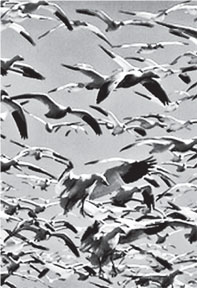The seasonal migration of birds
by K. G. H. Munidasa
Through the ages, the migration of birds has drawn the fascination of
man. It is a phenomenon that comes around twice each year in the autumn
and spring. In the Southern
 Hemisphere birds start to leave their
nesting territories near the Arctic Region or the Temperate Zone and fly
south with the advent of autumn (September or October to November). The
following spring (March or April to May) they commence their northward
flight along the same regular routes to re-occupy the territories they
vacated six months before. Although east to west migration has sometime
been observed its general direction as a whole is between North and
South. Hemisphere birds start to leave their
nesting territories near the Arctic Region or the Temperate Zone and fly
south with the advent of autumn (September or October to November). The
following spring (March or April to May) they commence their northward
flight along the same regular routes to re-occupy the territories they
vacated six months before. Although east to west migration has sometime
been observed its general direction as a whole is between North and
South.
Origin of migration
Various theories have been advanced by scientists to explain the
origin of bird migration. But the popularly accepted one is chiefly the
difficulties involved in finding their food supply under the adverse
wintry conditions that compel the birds to leave their habitats and fly
south towards the Tropics, where food is in abundance at all times. Like
the swing of a pendulum they return to the starting point when
conditions are favourable at home, once again.
There are roughly 30,000 different species and sub-species of birds
in the world today and nearly half of them are known to migrate
regularly. Broadly speaking, the migrant birds can be classed as animals
with two habitats or home territories; one to nest and breed and the
other to rest and feed. These habitats are often thousands of miles
apart, in different climatic belts and continents. Yet, twice a year
they travel between them, usually in scattered parties and occasionally
in massive flocks of thousands of individuals. They fly by night as well
as by day, over land masses, across lofty mountain ranges and deep
valleys, broad deserts, and finally converging on to accustomed routes
favoured by multitudes of migrants before them to reach their
destination.
It is said that day-flying birds take guidance from the angle the sun
shines at the appropriate season to maintain their course, while the
night-flyers are undoubtedly guided by the constellations of stars to
find their way in the darkness. This is explained by the fact that under
an overcast sky night flying migrants often lose their way and come to
grief.
Winter resorts
Tropical Africa is by far the most popular winter resort of numerous
migrants from Europe and Asia. It has been estimated that nearly a third
of all the small birds which breed in the British Isles have their
winter quarters in territories to the south of the Sahara desert. Large
numbers of birds from Central Asia fly regularly to Africa to escape the
riggers of winter, while other smaller birds go to Africa from the Far
East. The Alaskan Wheatear and the East Siberian Willow-Warbler annually
travel 7,000 miles up and down between their summer and winter quarters.
Between North and South America or Europe and South Africa the Common
Swallow covers 12,000 miles twice a year. The Eastern Golden Plover from
its breeding grounds in the Arctic regions migrates to Nova-Scotia and
then south across the Atlantic Ocean for a distance of 1,500 miles and
to the West Indies, thence to the southern parts of South America. In
the mean time other golden plovers cross the Pacific to the Hawaii
Island, South Pacific Islands and often to Australia.
The longest migratory journey of all is undertaken by the Arctic
Tern, which from the artctic winter flies south right across the globe
to the Antarctic summer and back again, a distance of 22,000 miles.
Heights
It was formerly theorised that on migration, birds flew at immense
heights. Although on account of their special attributes, birds are
capable of ascending to higher altitudes, it is now known that migratory
birds generally fly at heights under 1,300 feet or 1,000 feet, and still
lower over the sea where there are no obstacles to avoid. Yet, when
crossing mountain passes they ascend to stupendous heights. For
instance, members of an Everest Expedition have met with Crows and
Mountain Finches (sparrow family) at 23,000 ft. and Vultures soaring at
between 22,000 and 23,000 feet elevations. Sir Edmund Hillary during his
successful assault on Everest in 1953 came upon Choughs (crow family)
following the climbers at 28,000 feet.
Flying Speed
Scientists have been able to arrive at fairly accurate estimates of
the speed of various migrant birds, with the help of modern devices such
as radar and speed indicators. Such fast-flying species as ducks and
geese have been found to maintain a cruising speed of 50-60 miles per
hour or even higher in favourable weather.
It is found that under normal conditions, a bird's flying-day
averages from 6 to 11 hours.
The following are some of the non-stop flights on records: Coot 160
miles, Stork 125 miles (6 hrs) Woodcock (snipe) 250-300 miles, Plover
550 miles (11 hrs.) Non-stop flights of 2,000 miles across the open sea
are undertaken by the Eastern Golden Ploer. A resident snipe in Japan
flies regularly to Eastern Australia and Tasmania in winter covering an
enormous distance of 3,000 miles in a single ‘HOP'.
|

